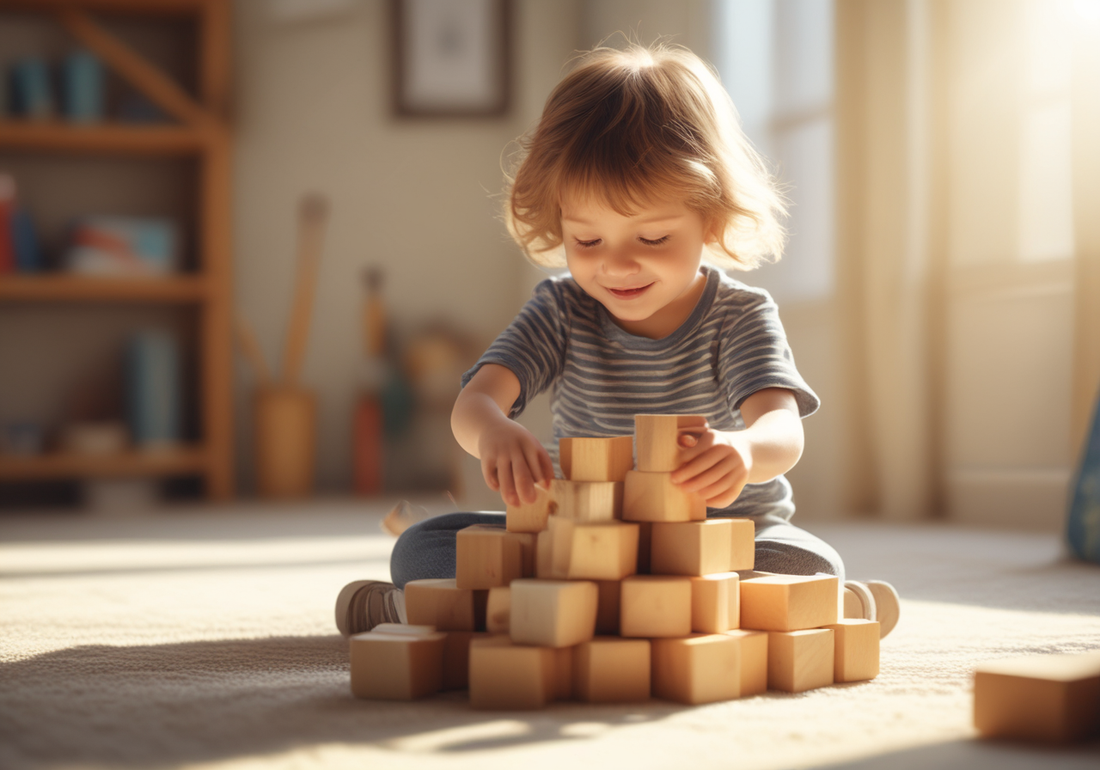Key Highlights
- Wooden toys are crafted from natural materials, offering a safer and non-toxic environment for children’s play.
- These toys promote educational benefits, supporting cognitive development and fine motor skills through creative play.
- Imaginative play flourishes with wooden toys, helping kids build social skills and emotional intelligence.
- Sustainability is a major advantage, as wooden toys are environmentally friendly and serve as durable plastic alternatives.
- The tactile experience of wooden blocks and textures brings sensory-rich engagement for young children.
- Parents value longevity, with wooden toys lasting a long time and providing lasting educational value.
Introduction
The charm of wooden toys lies not only in their aesthetic appeal but also in their myriad educational benefits. Crafted from natural materials, these play objects foster a safer environment for children, steering clear of toxic substances often found in plastic toys. As young minds engage in imaginative play, their cognitive development thrives, allowing fine motor skills and critical thinking to flourish. With the increasing demand for sustainable materials, wooden toys provide an excellent alternative, embodying durability and timeless value in children’s play.
Exploring the Benefits of Wooden Toys for Kids
 Delving into the advantages of wooden toys reveals their essential role in fostering children's development. These toys, crafted from natural materials, eliminate toxic materials often found in plastic toys, promoting a safer play environment. They enhance fine motor skills and stimulate cognitive development through imaginative play. The educational value of wooden toys lies in their ability to encourage critical thinking and creativity, making them a perfect toy for young children. Durable and sustainable, these toys truly benefit children of all ages.
Delving into the advantages of wooden toys reveals their essential role in fostering children's development. These toys, crafted from natural materials, eliminate toxic materials often found in plastic toys, promoting a safer play environment. They enhance fine motor skills and stimulate cognitive development through imaginative play. The educational value of wooden toys lies in their ability to encourage critical thinking and creativity, making them a perfect toy for young children. Durable and sustainable, these toys truly benefit children of all ages.
1. Promote Safer, Non-Toxic Playtime
Wooden toys stand out as a fantastic choice for parents concerned about safety, offering a non-toxic alternative to plastic toys laden with harmful chemicals. The use of natural materials eliminates the risk of sharp edges and toxic materials, ensuring a worry-free play environment for young children. This commitment to quality not only enhances the emotional intelligence of children through safe exploration but also nurtures critical thinking skills, reinforcing the importance of a secure and engaging playtime experience.
2. Encourage Creativity and Imaginative Play
Experiencing playtime with wooden toys sparks creativity in children, allowing them to explore diverse scenarios through imaginative play. Natural materials, such as timber, provide a tactile experience that encourages sensory engagement, enhancing emotional intelligence and cognitive development. Unlike plastic toys, these eco-friendly alternatives foster open-ended play, enabling kids to build, create, and innovate without limitations. The versatility of wooden blocks and educational wooden toys encourages young minds to express their ideas freely, cultivating critical thinking and enhancing social skills among peers over countless playdates.
3. Support Cognitive and Physical Development
Engagement in play using wooden toys significantly benefits both cognitive and physical development. These toys encourage children to explore problem-solving techniques and enhance critical thinking skills through imaginative scenarios. Manipulating shapes and building with blocks not only fosters fine motor skills but also aids in developing hand-eye coordination. Such interactive experiences stimulate various areas of a child's brain, leading to improved emotional intelligence and social skills as they share and collaborate during playtime. The structured yet open-ended nature of wooden toys enriches the overall play environment.
4. Align with Montessori Principles and Learning
Toys designed from natural materials seamlessly align with Montessori principles, emphasizing hands-on learning and freedom of choice in a child’s play environment. These wooden toys encourage self-directed exploration, enabling young children to engage in imaginative play that fosters cognitive development and emotional intelligence. By offering open-ended experiences, such as building blocks and educational wooden toys, they instill critical thinking and promote social skills. This harmonious relationship between play and learning cultivates an engaging atmosphere, supporting the holistic growth of children of all ages.
5. Environmentally Friendly and Sustainable Choice
Choosing wooden toys means opting for an environmentally friendly and sustainable alternative to plastic toys. Crafted from natural materials, these toys contribute to a reduced environmental impact while promoting responsible consumption. Their longevity ensures that they can endure years of play, minimizing waste at the end of their life. Furthermore, many wooden toys are produced using eco-conscious practices, enhancing their appeal to parents seeking sustainable options. The transition to wooden alternatives not only supports child development but also encourages a deeper connection with nature.
6. Enhance Fine Motor Skills and Problem Solving
Hands-on play with wooden toys significantly enhances fine motor skills. As children grasp small pieces, stack blocks, or manipulate various shapes, they refine their hand-eye coordination and dexterity. These activities encourage critical thinking, allowing children to solve simple problems, such as how to balance blocks or fit shapes together. The tactile nature of wooden materials offers natural textures that stimulate sensory exploration. This sensory-rich experience not only fosters cognitive development but also promotes creativity, building a strong foundation for their future learning.
7. Offer Durability and Longevity for Years of Play
Wooden toys stand out for their remarkable durability, making them a wise investment for families. Crafted from natural materials, these toys resist wear and tear, often lasting through generations of play. Unlike their plastic counterparts, wooden options avoid breaking easily, ensuring safe play environments. This sturdiness not only supports emotional intelligence as children engage in creative play but also fosters a sense of responsibility among young users. The longevity of wooden toys plays an essential role in child development, promoting sustainable choices for parents.
8. Provide Sensory-Rich Experiences
Engaging with wooden toys fosters sensory-rich experiences that significantly enhance a child's play environment. The natural textures and weight of these toys stimulate tactile exploration, promoting fine motor skills and sensory development. Unlike plastic toys, wooden toys offer unique sounds and visual appeal, which enrich imaginative play. These elements not only capture attention but also encourage children to engage in creative problem-solving, thereby stimulating cognitive development and emotional intelligence. Such experiences lay the groundwork for fostering deeper understanding and connections in the child’s brain.
9. Cultivate Appreciation for Handcrafted Quality
Handcrafted wooden toys represent a commitment to quality and artistry, often showcasing unique designs that mass-produced plastic alternatives lack. This appreciation for craftsmanship can instill in children an understanding of the value of patience and the importance of skilled labor. Engaging with these toys nurtures their emotional intelligence as they learn to value not just the play experience but also the story behind each piece. Such interactions with natural materials foster a connection to their origins, promoting a sense of sustainability and respect for the environment.
10. Suitable Options for Different Age Groups
A wide variety of wooden toys cater to different developmental stages, ensuring suitability for children of all ages. Infants benefit from simple shapes and sensory-rich textured blocks, enhancing their cognitive skills and exploration. As toddlers grow, building sets and imaginative play toys promote creativity and social skills. Preschoolers can enjoy more complex wooden puzzles and interactive games that foster critical thinking and emotional intelligence. Adapting toy options according to age empowers parents to make informed choices that significantly contribute to child development.
Key Considerations When Choosing Wooden Toys in India
 Safety standards and non-toxic finishes should be prioritized to ensure a healthy play environment for children. Evaluating age appropriateness and educational value is also essential, as this aligns with promoting cognitive development and fine motor skills. Additionally, consider the craftsmanship and material quality, which are crucial for longevity and sustainability. By selecting wooden toys made from sustainable materials, you not only provide children with safe and engaging options but also minimize environmental impact, making a responsible choice for future generations.
Safety standards and non-toxic finishes should be prioritized to ensure a healthy play environment for children. Evaluating age appropriateness and educational value is also essential, as this aligns with promoting cognitive development and fine motor skills. Additionally, consider the craftsmanship and material quality, which are crucial for longevity and sustainability. By selecting wooden toys made from sustainable materials, you not only provide children with safe and engaging options but also minimize environmental impact, making a responsible choice for future generations.
Look for Safety Standards and Non-Toxic Finishes
A strong focus on safety standards is crucial when selecting wooden toys. Opt for products that adhere to recognized certifications, ensuring they are free from toxic materials. Non-toxic finishes not only safeguard children during play but also enhance their overall experience with natural textures. Additionally, examining the craftsmanship behind wooden toys guarantees no sharp edges, promoting a safer play environment. Prioritizing these aspects fosters peace of mind and supports children’s health, ultimately enriching their playtime with high-quality, safe products.
Evaluate Age Appropriateness and Developmental Value
Selecting toys that match a child's developmental stage is crucial for nurturing their growth. Educational wooden toys offer varying levels of challenge, which can significantly engage their cognitive development and fine motor skills. Younger children thrive on simple, safe designs, such as building blocks, while older kids may benefit from more complex structures that promote critical thinking and problem-solving. Evaluating these aspects ensures that playtime is both enjoyable and enriching, fostering essential social skills and creativity through age-appropriate interactions.
Assess Craftsmanship, Material Quality, and Sustainability
Evaluating craftsmanship in wooden toys involves examining the attention to detail and the construction techniques used. High-quality materials like sustainably sourced wood enhance durability, ensuring they withstand prolonged use. Look for non-toxic finishes that foster a safe play environment free from harmful chemicals. Additionally, considering the sustainability of these toys significantly impacts their life cycle; biodegradable options provide a minimal environmental footprint. This not only supports child development but also instills values of ecological awareness in young children.
Conclusion
Exploring the advantages of wooden toys for kids reveals their integral role in promoting a healthier, more enriching play environment. Their ability to foster imaginative play and support cognitive development makes them an ideal choice for engaging young minds. With a focus on natural materials, these toys provide safe, non-toxic alternatives to plastic. Ultimately, selecting high-quality wooden toys can significantly impact children’s social skills, emotional intelligence, and fine motor skills, ensuring years of enjoyable, educational play.
Frequently Asked Questions
Are there any drawbacks or safety concerns with wooden toys?
While wooden toys are generally safe, potential drawbacks include splintering and choking hazards with small parts. Additionally, poor craftsmanship may lead to toxic finishes or unsafe designs. Always choose high-quality, non-toxic options to mitigate these concerns for safe playtime experiences.
How do I select the best wooden toys for my child’s age and development?
To select the best wooden toys for your child's age and development, consider their safety, developmental benefits, and interests. Look for age-appropriate designs that stimulate creativity and motor skills while ensuring the toys meet safety standards. This thoughtful selection supports healthy growth through play.
Do wooden toys really last longer than plastic toys?
Yes, wooden toys generally outlast plastic ones due to their robust materials and craftsmanship. They withstand rough play, resist wear and tear, and are not prone to fading or breaking easily. This durability makes them a more sustainable choice for long-term use in children's playtime.

